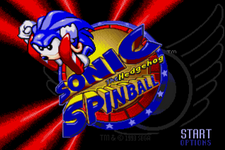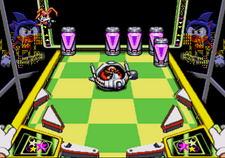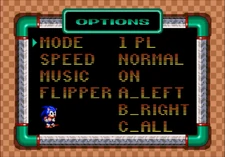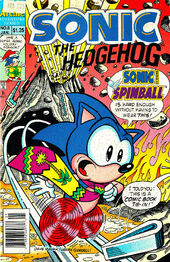- For other uses, see Sonic Spinball (disambiguation).
- Not to be confused with Sonic Pinball Party.
Sonic Spinball (ソニックスピンボール Sonikku Supinbōru?), also known as Sonic the Hedgehog Spinball, is a pinball-style spin-off video game in the Sonic the Hedgehog series that was developed by the American members of Sega Technical Institute in association with Polygames. Released for the Sega Mega Drive in 1993, an alternate version of the title was also released for the Sega Master System and the Sega Game Gear the following year.
In Sonic Spinball, Dr. Eggman has built the Veg-O-Fortress, a stronghold used to turn Animals into Badniks for his robot army. Having infiltrated the base to thwart the scientist's ambitions, Sonic must make his way through the Veg-O-Fortress's pinball-based defense system to rescue the kidnapped Animals and bring the fortress down.
Sonic Spinball received mixed reviews; while the presentation and visuals were well received, critics were more divided on aspects such as the controls and the physics. Another pinball-based game, Sonic Pinball Party, would be released over ten years later for the Game Boy Advance, though the two games do not have any relation.
Plot[]

The title screen of Sonic Spinball.
Set on "Planet Mobius",[note 1] the story of Sonic Spinball starts with Dr. Eggman returning to his evil ambitions by kidnapping Animals and turning them into Badniks to do his bidding. As part of his operations, the villain sets up a new fortress, the Veg-O-Fortress, on Mount Mobius, that is powered by volcanoes and Chaos Emerald energy. This stronghold is protected by a "pinball defense system" that houses the sixteen Chaos Emeralds that fuel the structure.[1]
Eventually, Sonic and Tails approach the Veg-O-Fortress using an airplane the latter is piloting. While saying this operation will be tougher than usual, the hedgehog believes he will succeed once he takes out the Chaos Emeralds from the stronghold. He then jumps out of the plane as his friend wishes him luck.[1] Ending up in the Toxic Caves, the lowest point of Eggman's base, Sonic goes on a hunt for the Emeralds.
After Sonic succeeds in collecting all but five of the Chaos Emeralds and destroying the Veg-O Machine that turns the Animals into Badniks, the Veg-O-Fortress starts to crumble. Dr. Eggman tries to escape in his rocket ship, only for his nemesis to invade it, collect the final Emeralds, and defeat the doctor onboard it, destroying his ship. As both adversaries fall from the sky, the hedgehog is saved by Tails with his airplane, while the villain falls into his crumbling base as it sinks into the sea.
Gameplay[]

Sonic in Toxic Caves, the first level in the game.
Sonic Spinball is a 2D side-scroller pinball-themed game where the player must guide Sonic (who assumes the role of the "ball") through several levels. While Sonic is curled into a ball, the player can use flippers to launch Sonic upward and/or across the respective levels. When Sonic is not curled into a ball, his moveset resembles that from the main titles in the Sonic games; in addition to being able to walk around on the floors of the pinball table-based levels, Sonic can also jump, duck, and perform the Super Spin Dash.
Throughout the game, the player's objective is to collect Chaos Emeralds, which are hidden around the levels. Each level has a different amount of Emeralds to collect. Their collection is obligatory, as collecting them all lets the player fight the boss of the level and progress with the game. Each Emerald is required to be collected in different ways though.
Like other Sonic games, Sonic Spinball features a lives system. However, the player cannot take conventional damage throughout the game; Sonic can only die if he falls off a level's pinball table. If Sonic dies, the player will be able to continue playing at the cost of a life. Losing all lives will result in a Game Over. Various actions in the game (such as collecting Rings or destroying Badniks) reward the player with a determinate amount of points. Collecting twenty million points will grant the player an additional life.
The Status Strip[2] is an unique feature that appears in Sonic Spinball. It is basically a dark blue notification bar located on the top part of the HUD. In gameplay, it gives the player useful information about their progress. Depending of what the player does, the Status Strip may give them the following pieces of information:
- Player Number and Lives: Shows which player is playing, their current level, their points, and lives.[2]
- Emeralds: Shows how many Chaos Emeralds the player needs to snag in a level. It also shows the player's progress while trying to find an Emerald.[2]
- Urgent Orders: Tells the player to hit a target nearby. It also warns about a dangerous event that is about to happen.[2]
- Loop Successes: Shows how many loops the player has completed.[2]
- Score Update: Shows the player's current score.[2]
- End Totals and Bonuses: Totes up the player's score, loops, Rings and time at the end of a level.[2]
- Sonic Status: Notifies that the player has lost a life. If the player does not have any lives left, the Status Strip will tell the player that they have received a Game Over.[2]
Controls[]
| Button formation | Movement | |
|---|---|---|
| Sonic | Pinball | |
| Move left/right | ||
| Look Up | N/A | |
| Duck | ||
| Jump | Tilt left Flippers | |
| Tilt right Flippers | ||
| Tilt both Flippers | ||
| Super Spin Dash | N/A | |
| N/A | Shake (Bonus Stages) | |
| START | Pause | |
Objects[]
Items[]
Gimmicks and obstacles[]
- Balloon
- Bumper
- Capsule
- Drain Bumper
- Flipper
- High-speed warp tube
- Minecart
- Sewer Warp
- Triangle Bumper
Characters[]
Playable characters[]
Non-playable characters[]
- Animals
- Bunnie Rabbot (cameo)
- Dr. Eggman
- Hip and Hop (first appearance)
- Miles "Tails" Prower
- Muttski (cameo)
- Rotor (cameo)
- Sally (cameo)
Enemies[]
|
|
Bosses[]
- Scorpius (Toxic Caves)
- Roboiler (Lava Powerhouse)
- Veg-O Machine (The Machine)
- Robotnik's Ship (Showdown)
Levels[]
Sonic Spinball consists in four levels, where the player's main goal is to find a certain number of Chaos Emeralds in order to advance. Doing so will allow the player to enter a boss room where they will fight the boss of that level. The levels are:
- Toxic Caves: A stinky cavern full of toxic sludge and mine carts. There are three Chaos Emeralds to collect here.
- Lava Powerhouse: A power station of sorts that uses magma and steam energy to run various machines. There are three Chaos Emeralds here.
- The Machine: A high-tech level where Animals are robotized. Five Chaos Emeralds must be found here.
- Showdown: A rocket ship Dr. Eggman tries to use to escape. There are five Chaos Emeralds here.
Bonus Stages[]

A Bonus Round.
At the end of each of the first three stages, Sonic gets to play a Bonus Round. They are set up like real pinball machines, with Sonic at the controls. The player is given a task to complete and three balls to play with. Flipper controls are the same as in the normal game, but the ball cannot be controlled with the D-pad like Sonic. Pressing all the flipper buttons at once will make Sonic shake the machine, though repeated shakes will cause a 'tilt' and lock the flippers.
Completing the Bonus Rounds are optional, as they only serve to increase the player's score.
Other modes[]
Options[]

The Options menu in Sonic Spinball.
Options is the settings menu for Sonic Spinball which holds the following options:
- Mode: Select one to four players. All players will take turns controlling Control Pad 1.
- Speed: Choose a Normal or Fast game.
- Music: Turn the game's music ON or OFF.
- Flippers: Choose one's desired settings for buttons
 ,
,  and
and  .
.
Development[]
Background[]
Because of Sonic the Hedgehog 2 being a commercial success for the Sega Mega Drive in 1992, Sega wanted a Sonic game to be released in the console in 1993 as well. After realizing that the Japanese members of the Sega Technical Institute (STI), the team that had developed Sonic 2, was busy making Sonic the Hedgehog 3, which would not be released until 1994, Sega of America tasked the American staff of the STI with making a Sonic game for the 1993 holiday season.[3][4]
Conception[]
Based upon research from Sega, the crew came to the conclusion that Casino Night Zone was one of the most liked Zones in Sonic the Hedgehog 2. This gave developer Peter Morawiec the idea of making a pinball-styled game, combining the Amiga game Pinball Dreams with Sonic gameplay mechanics. Collaborating with three colleagues, Morawiec designed basic animations depicting Sonic as a pinball ball. The project was eventually approved after the animations had been demonstrated to Sega's senior management.[3]
Sega tasked the developers to complete the game in time for the 1993 holiday season, which was considered a "tight" schedule for a game that would capitalize on the series' popularity in North America according to Morawiec. In an attempt to speed up production, Sega sent Japanese staff to help with the project, including Sonic the Hedgehog artist Katsuhiko Sato. However, the game was still not predicted to be finished in time. Because of this, the developer team had to change the production code for the game from assembly to C to accelerate development. This was considered an atypical approach for the Sega Mega Drive, and it caused several frame rate and optimization problems.[5][3] Despite this, the team managed to polish and complete the game within a month.[3]
Soundtrack[]
Immediately before Sonic Spinball was released, the developer team was informed that Sega did not own the rights to the theme music for the original Sonic the Hedgehog. Later, Hirokazu Yasuhara, the lead designer on Sonic Team, explained that the music was owned by Japanese band Dreams Come True, whose songwriter Masato Nakamura composed the soundtrack for the first two Sonic main titles. As such, Morawiec tasked lead composer Howard Drossin to write a new theme within two hours.[3]
Reception[]
| Reception | |
|---|---|
| Aggregate scores | |
| Aggregator | Score |
| GameRankings | 61.00%[6] |
| Metacritic | 68% (iOS)[7] |
| Review scores | |
| Publication | Score |
| Computer and Video Games | 73%[8] |
| Electronic Gaming Monthly | 7/10[9] |
| Eurogamer | 4/10 (Wii)[10] |
| GamePro | 7/10[11] |
| GameSpot | 6.1/10 (Wii)[12] |
| IGN | 7.5/10 (Wii)[13] |
| Mean Machines Sega | 81%[14] |
| Nintendo Life | 4/10 (Wii)[15] |
| Sega Power | 90%[16] |
| Jeuxvideo.com | 15/20[17] |
| Entertainment Weekly | C[18] |
Sonic Spinball received mixed reviews from critics, holding a score of 61.00% at the video game review aggregator GameRankings.[6]
The visuals of the game were praised.[9][13][17] A reviewer from Electronic Gaming Monthly thought that the game set inside "a pinball machine" was a novel idea, and also labelled the game's visuals, music, and sound effects as "top notch".[9] In the same review however, another reviewer thought that the graphics were not as "sharp" as other Sonic the Hedgehog titles, and also thought the sound was unimpressive.[9] In a retrospective review, Lucas Thomas from IGN said that the visuals "matched those from other Sonic games on the Genesis", and felt that the Bonus Rounds were visually distinct and well-done.[13] A reviewer from Jeuxvideo.com thought that the graphics were "generally good", but also felt that there were other visually superior Genesis games.[17] In a similar vein, William Avery of GameSpot noticed that the game contained some slowdown.[19] Eurogamer's Dan Whitehead criticized the game's sluggish frame rate and slowdown that occurred when "things threaten to get hectic" in-game, noting that it suffered from "the old Mega Drive problem".[10]
Several other aspects of the game, especially the controls and physics, received mixed criticism.[10][13][18][11] A reviewer from GamePro criticized the control configuration and felt that the game was a mediocre example of a pinball game, but admitted that it had a similar feel to previous Sonic the Hedgehog titles.[11] Jeuxvideo.com's reviewer enjoyed how Sonic himself acted as a pinball ball, but noticed that the controls were less precise and responsive when compared to other platformers.[17] Dan Whitehead said that the game's controls were "muddled by the half-and-half approach", and criticized the "clunky" game engine, saying that the game's control scheme ruined the pinball environments.[10] Thomas stated that "there are aspects of the control that could have been tighter, and its difficulty level may be a bit too extreme for new players."[13] Damien McFarren from NintendoLife said that the game comes across as both a poor platformer and a poor pinball game due to its unconvincing ball physics and frustrating platform elements.[15] Bob Strauss of Entertainment Weekly felt that the game initially boasted a terrific concept, but had an ultimately flawed execution, saying that Sonic, acting as a pinball, often moved like a "leaden marble".[18] Rich Leadbetter from Mean Machines Sega criticized the game's lack of replay value, saying that despite its addictive gameplay, the four levels were not enough, especially given the price.[14]
Adaptations[]

The front cover of Archie's Sonic the Hedgehog issue 6.
The Sonic the Hedgehog comic series published by Archie Comics made an adaptation of Sonic Spinball in issue 6. The story covered the first two levels of the game, and several elements are also reused here.
Re-releases[]
| Image | Game | Platform | Description |
|---|---|---|---|

|
Sega Smash Pack | PC | Released in a compilation of other Sega Mega Drive games in 2002. |

|
Sonic Mega Collection | Nintendo GameCube | Released in a compilation of other Sega Mega Drive games in 2002. |

|
Sega Smash Pack | Game Boy Advance | Released in a compilation of other Sega Mega Drive games in 2002. |

|
Sonic Mega Collection Plus | PlayStation 2 Xbox Microsoft Windows |
Released in a compilation of other Sega Mega Drive and Sega Game Gear games in 2004. |

|
Sonic Gems Collection | Nintendo GameCube PlayStation 2 |
Released in a compilation of other Sega Mega Drive and Sega Game Gear games in 2005. |

|
Sonic Spinball | Wii | Released for the Virtual Console in 2007. |
| Sonic Spinball | Browser | Made available for VIP users to play on the PlaySega browser game service, which launched in 2008. | |

|
Sonic's Ultimate Genesis Collection | Xbox 360 PlayStation 3 |
Released in a compilation of other Sega Mega Drive and Sega Master System games in 2009. |
| Sonic Spinball | Steam | Released in 2010. | |

|
Sonic Spinball | iOS | Released in 2010, removed in 2015.[20] |
| Sonic the Hedgehog: Ultimate Bundle | PC | Released in a compilation of other Sonic games released for Steam in 2020. | |

|
Sonic Spinball | Nintendo Switch | Available with a Nintendo Switch Online + Expansion Pack membership, included in the Sega Genesis library in 2022. |
Trivia[]
- Sonic Spinball was the first Sonic and Sega Genesis game that composer Howard Drossin worked on. On his first day of employment at the Sega Technical Institute, his initial task was to compose the games entire soundtrack. The very first track he composed for the game was the Toxic Caves theme, which was started and completed within his first day on the job. Surprisingly, Howard accomplished this despite lacking any prior knowledge of how to use the Genesis YM2612 sound chip. (He had lied about knowing how to in order to get the job in the first place)[21]
- Sonic Spinball was planned to be re-released for PC in 1995, under the "Sega PC" lineup of titles. Although box artwork for the port was created, it ultimately was unreleased.[22]
- A prototype from shortly before the release of the game used a rendition of the title screen of Sonic the Hedgehog. Additionally, the message "You Lose" also originally said "Loser".
- The European version of the game has a faster intro theme and options theme, as well as faster background music for Lava Powerhouse.
- The total Chaos Emerald count in Sonic Spinball is sixteen, as opposed to the standard set of seven. Also, all the gems are colored blue.
- Characters from the Sonic the Hedgehog television series appear in cameos in one of the Bonus Stages, making this the only game thus far to feature content from that show in a Sonic game.
- This marks the only known time Mobius was referred as in a Japanese source.[23]
- Unlike other Sonic games, Dr. Eggman appears to have visible eye pupils in front of his glasses.
- In the game, Dr. Eggman's bodysuit and gauntlets appear to be slightly based off his Adventures of Sonic the Hedgehog design, its more noticable in an early screenshot of a deleted cutscene. The cover for the west however depicts him in his original American design where he has usual (classic) attire, empty black eyes, and a lack of gloves.
- With the appearance of Scratch from the Adventures of Sonic the Hedgehog television series in one of the Bonus Stages, this game is one of the two titles to feature content from that cartoon, the other being Dr. Robotnik's Mean Bean Machine, which was released around the same time.
- Initially, according to Ian Flynn, Sonic Spinball was regarded as non-canon,[24] however he later went on to refer to it as being part of the established timeline.[25]
- Due to the above, this would imply that the old American backstory for the game, which follows the older western Sonic lore that sets his world on Mobius, has been retconned by its Japanese manual to place the events of Spinball on a different planet by the same name as Mobius.[1]
- In North America, the game was released on Doctor Who's 30th Anniversary.
Videos[]
Notes[]
- ↑ Sources are divided in the location of Sonic Spinball: the international manuals call the game's planet "Mobius", in line with Western media at the time. Noticeably, Japanese manuals also use "Mobius", but imply that it is a different planet from Sonic's home world by saying that Dr. Eggman has "invaded" the planet. In Sonic Origins' main menu, the Veg-O-Fortress, the setting of the game, is placed alongside other settings from the Classic games, but otherwise makes no allusion to "Mobius".
References[]
- ↑ 1.0 1.1 Sonic Spinball (Sega Mega Drive) Japanese instruction booklet, pgs. 4-5.
- ↑ 2.0 2.1 2.2 2.3 2.4 2.5 2.6 2.7 Sonic Spinball (Sega Genesis) United States instruction booklet, pgs. 10-11.
- ↑ 3.0 3.1 3.2 3.3 3.4 Machin, Cole (January 2011). "The Making of: Sonic Spinball". Retro Gamer (Imagine Publishing) (85): 37-39. Archived from the original. Retrieved on 30 January 2020.
- ↑ Retro Gamer staff (March 2007). "Company Profile: Sega Technical Institute". Retro Gamer (Imagine Publishing) (36): 30. Archived from the original. Retrieved on 22 March 2020.
- ↑ Horowitz, Ken (20 April 2007). Interview: Peter Morawiec (STI Programmer). Sega-16. Archived from the original on 15 March 2013. Retrieved on 30 January 2020.
- ↑ 6.0 6.1 Sonic Spinball for Genesis. GameRankings. Archived from the original on 4 March 2016. Retrieved on 11 February 2017.
- ↑ Sonic Spinball (iOS). Metacritic.
- ↑ Ahmet, Deniz (December 1993). "Review: Sonic Spinball". Computer and Video Games (145): 77. Archived from the original.
- ↑ 9.0 9.1 9.2 9.3 EGM staff (March 1994). "Review Crew: Sonic Spinball!". Electronic Gaming Monthly (Future plc) (53): 48. Archived from the original. Retrieved on 22 March 2020.
- ↑ 10.0 10.1 10.2 10.3 Whitehead (18 May 2007). Virtual Console Roundup. Eurogamer. Archived from the original on 4 September 2017. Retrieved on 13 February 2017.
- ↑ 11.0 11.1 11.2 GamePro staff (September 1994). "ProReview: Sonic Spinball". GamePro (IDG Entertainment) (62): 136. Archived from the original.
- ↑ Provo, Frank (19 March 2007). Sonic Spinball Review. GameSpot.
- ↑ 13.0 13.1 13.2 13.3 13.4 Thomas, Lucas M. (27 March 2007). Sonic Spinball VC review. IGN. Archived from the original on 10 September 2017. Retrieved on 4 February 2021.
- ↑ 14.0 14.1 Leadbetter, Rich (December 1993). "Sonic Spinball review". Mean Machines Sega (EMAP) (14): 70–72, 109. Archived from the original. Retrieved on 21 October 2017.
- ↑ 15.0 15.1 McFarren, Damien (13 March 2007). Review: Sonic Spinball (Virtual Console / Sega Mega Drive). Nintendo Life. Archived from the original on 27 September 2017. Retrieved on 13 February 2017.
- ↑ Mortlock, Dean (December 1993). "Mega Drive Review: Sonic Spinball". Sega Power (49): 95,96. Archived from the original.
- ↑ 17.0 17.1 17.2 17.3 Test Sonic Spinball sur MD (French). Jeuxvideo.com (29 January 2010). Archived from the original on 21 October 2017. Retrieved on 4 February 2021.
- ↑ 18.0 18.1 18.2 Strauss, Bob (11 February 1994). Sonic CD; Sonic Chaos; Sonic Spinball; Sonic 3. Entertainment Weekly. Archived from the original on 21 October 2017. Retrieved on 4 February 2021.
- ↑ Score, Avery (2 November 2004). Sonic Mega Collection Plus Review. GameSpot. Archived from the original on 18 September 2017. Retrieved on 13 February 2017.
- ↑ SEGA Flips Sonic Spinball App into the App Store. IGN. Archived from the original on 18 February 2017.
- ↑ https://www.thesegalounge.com/118-howarddrossin2/
- ↑ SEGA Forever on Twitter. Twitter (July 27, 2023). Retrieved on July 27, 2023. "SEGA Forever: From the archives: While Sonic CD and Sonic & Knuckles made it to the PC, it appears Sonic Spinball was also planned for a port in 1995! - Comix Zone and Ecco the Dolphin got enhanced released the same year - I wonder what enhancements it could have had?"
- ↑ Sonic Spinball (Sega Mega Drive) Japanese instruction booklet, pg. 4.
- ↑ Ian Flynn on Twitter. Twitter (16 April 2019). Retrieved on 14 May 2023. "Andrew DeCrescenzo: This is also supported by the Easter egg that @AdamBryceThomas drew in the digital comics. In conclusion, at least Sally, Muttski, Bunnie, and Rotor are canon to the games, at least during this adventure. They were prisoners along with Tails. @IanFlynnBKC , here’s your chance! / Ian Flynn: Sonic Spinball is not a canon game. Adam's easter eggs are small nods, nothing more."
- ↑ BumbleKast for July 11th, 2022 - Priority Q&A Podcast with Ian Flynn (50:01). YouTube (July 11, 2022). Retrieved on July 16, 2023.
External links[]
- Sonic Spinball at Wikipedia, the free encyclopedia
| Playable characters | Sonic | |
| Non-playable characters | Tails · Eggman · Animals (Flicky, Cucky, Locky, Wocky) · Sally · Bunnie Rabbot · Rotor · Muttski · Hip and Hop | |
| Stages | Toxic Caves · Lava Powerhouse · The Machine · Showdown · Bonus Stages | |
| Enemies | Buster · Buzz Bomber · Cluckbird · Clucker · Crawl · Ferron · Krondor · Magma Worm · Rexxon · Robohead · Scratch | |
| Bosses | Scorpius · Roboiler · Veg-O Machine · Robotnik's Ship | |
| Moves/techniques | Cliffhanger Flip · Crouch · Spin Attack · Spin Dash · Spin Jump | |
| Gimmicks and obstacles | Balloon · Bumper · Capsule · Flipper · High-speed warp tube · Minecart · Sewer Warp · Triangle Bumper | |
| Items | Chaos Emerald · Drop Target · Ring | |
| Albums | Sonic the Hedgehog Boom · Sonic Spinball (vinyl album) | |
| Other | Life · Mount Mobius · Planet Mobius · Sonic Spinball (LCD game) · Sonic Spinball (Life Savers) · Star Circle · Veg-O-Fortress | |



